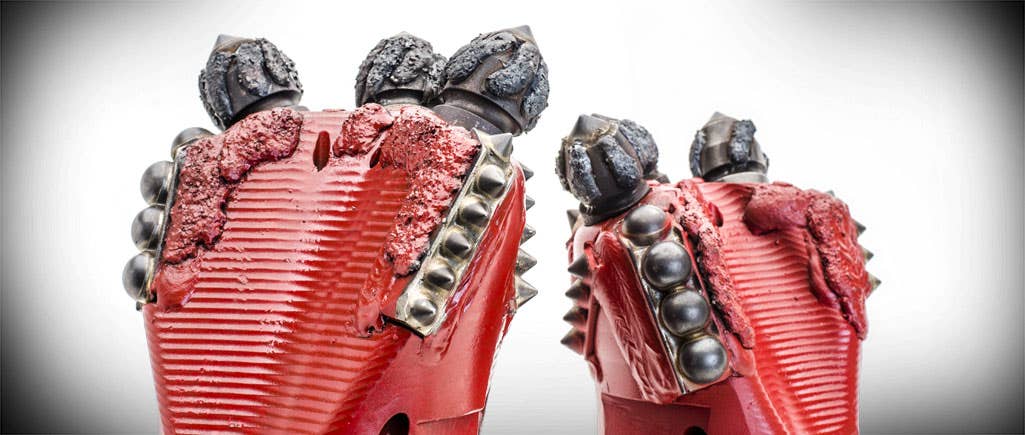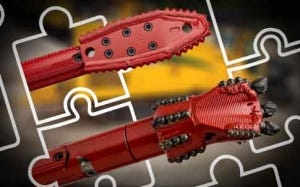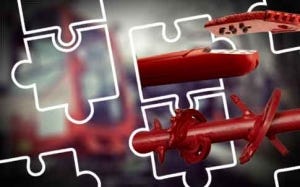
Directional Blades, or duckbills, are the old standby when it comes to directional drill products. There’s a reason they are included with most drill rigs: they’re sturdy, reliable and perform well under a variety of ground conditions. True, a duckbill is versatile and relatively inexpensive–but it comes with some important tradeoffs. Duckbills struggle through hard, rocky conditions. Most duck bills feature carbide protection, but usually not enough, so they wear out more quickly. Your duckbill might perform well when drilling straight but can’t deliver when you stop the drill head rotation during a steering path. For these common situations, you’ll need a few other bits your tool shed to keep production running smoothly. Here are our recommendations for high-performance bits to use when a buck bill just won’t cut it. 
Eagle Claw
This bit features a lot more mass than a duck bill, so it will last longer. It’s a no-brainer for drilling through shale, since coarse materials cause so much wear and tear on a blade. The Eagle Claw’s three replaceable carbide-tipped teeth are able to fracture the shale and penetrate the ground quickly, especially when using the bit in a rocking motion. Sure, you might get adequate carving action out of a standard blade, but the Eagle Claw will get the job done a lot more quickly and efficiently–and live to drill another day. 
Super Eagle Claw
The Super Eagle Claw is like the big brother to the standard Eagle Claw. Same bones, but with more oomph. Our engineers examined the exact wear patterns on the Eagle Claw and noticed the specific areas that were subject to greater stress. We added more aggressive carbide in these high-wear areas, which help the bit last even longer under strenuous conditions. The added carbide on Super Eagle Claw performs especially well in reducing wear on the bit’s areas that come into play during direct pullback. Extra carbide cutter blocks help with cutting and reduce wear during backward movement.
Iron Fist
The Iron Fist is the ideal bit for use in rockier conditions, from gravel up to grapefruit size cobblestones. These are difficult materials to drill, no matter what. But this is where it’s incredibly important to rely on directional drill products designed especially for these soil types. Because the edges of most bits protrude over the transmitter housing, when rotating the drill or wobbling through solid mass, the blade’s blunt back edge can allow cobble to fall in and get stuck. Iron Fist’s concave design causes the cobble to roll off the edges of the bit, thus pushing it out of the way. In these conditions, it’s not necessarily about breaking through the cobble (although the Iron Fist can handle that, too) as much as it is drilling a path through the stones and moving them aside without jamming up the machinery. 
Mud Motor
HDD is not just about drilling a straight bore path–it’s about being able to change directions when needed, even when drilling through solid rock. This is where mud motors shine. A mud motor operates using the flow and pressure of the drill fluid, allowing the bit to spin independently from the drill rod, so you don’t need to stop the bit’s rotation for steering. The drill bit on a mud motor is on a bent sub, which enables steering while maintaining rotary cutting action. Mud motors can only be used on drill rigs with a 40,000-lb. thrust rating or higher with at least 50 gpm drill fluid flow, so they are not for small rigs. They’re also a heftier investment than a standard blade, but the trade-off is exceptional in terms of performance and durability when up against solid rock. 
The ROI of the Right Bit
There are alot of directional drill products on the market that have been specially designed to handle a variety of conditions you’ll encounter as a driller. Investing in the right bit pays off down the line. For example, say you’re in some tough cobbles, but it’s only a 400’ shot. You think you can do it with your duck bill. But you end up only getting 200’ in one day–plus, now your blade is pretty much shot. You’re getting paid by the foot, not by the hour. But your drillers are paid by the hour. Instead of making the shot in one day, making you a cool $4,000/day (assuming $10/foot), you’re only making $2,000 for the day. Plus, you can’t start the next shot yet and you have to buy a new duck bill.  The right bit (in this case, an Iron Fist) would have cost you about $1,000 more than a duck bill, but it would have gotten the job done on day one and would still be working on the next shot, and the next one, and the next one...
The right bit (in this case, an Iron Fist) would have cost you about $1,000 more than a duck bill, but it would have gotten the job done on day one and would still be working on the next shot, and the next one, and the next one...
The bottom line is: getting the right HDD equipment for the job will pay off big in terms of efficiency and productivity.
For questions about the best tool for your job, contact your local Melfred Borzall distributor.





